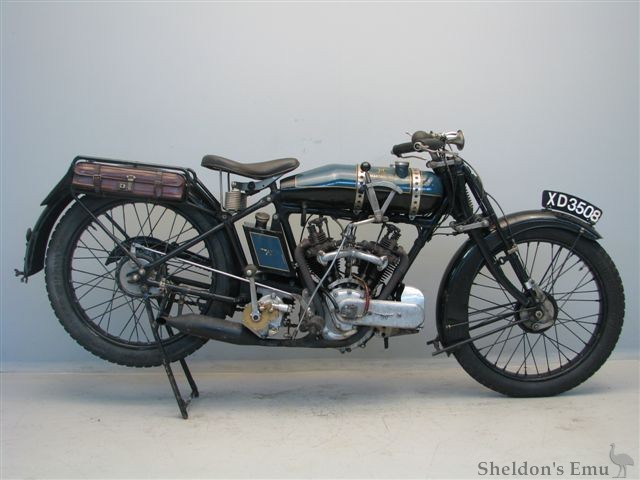



Martinsyde Range Extended by the "Quick-Six."
A Speedy 739 c.c. Solo Mount.

A speed machine which looks its part and is appropriately named the "Quick-Six".

New detachable exhaust valve cage with a ribbed extension.

How the adjustable handlebars are provided with a positive lock by means of a knurled clip.

An experimental valve gear embodying leaf springs.
TO be added to the list of attractive sports models already on the market is the "Quick-Six" Martinsyde, the happy name for which the well-known rider, H. H. Bowen, head of the firm's technical department, is responsible.
It was this machine which behaved so well in the recent Kop Hill climb, winning its class at 56 m.p.h. on the occasion of its first appearance in public.
Improved Cylinder Heads.
Considerable improvement has been made in the design of the cylinder head, which is detachable. Instead of the exhaust issuing from the cylinders at an acute angle the detachable head incorporates a special exhaust cage, heavily ribbed with radiating fins, while the addition of streamline ports adds greatly to the efficiency. Of course, the distinctive Martinsyde feature of overhead exhaust and side inlet is retained. Ricardo pistons are fitted, and each flywheel is machined and accurately balanced. All reciprocating parts have been lightened, while the connecting rods are of nickel steel and machined all over.
Another feature which is worthy of mention is that the length of the cylinder has been so designed that the top ring just emerges into the head by 10-l,000ths of an inch, thus preventing any ridge being formed at the top. A plain copper washer is employed to ensure gas-tightness at the head joints, this being found to be quite as efficient as a copper and asbestos washer. The same type of washer is also employed for the exhaust cage. Cone-type compression valves are fitted instead of compression taps, as these have been found to be far more satisfactory.
A close-ratio gear box is fitted, the ratios being in the proportion of 1, 1.5, and 1.8; the actual gears are: top 3.6, second 5.4, and bottom 9.1 to 1.
Foot-controlled Oil Pump.
A separate oil tank is now fitted, and in future models the oil pump will be foot-operated, while in the final design both brakes will be of the dummy belt rim variety, with compensating arrangement on the shoes to ensure a parallel movement. The price of the machine is £150, and it is manufactured by Martinsyde, Ltd., Maybury Hill, Woking, Surrey.
The Motor Cycle, 11th May 1922, page 599.